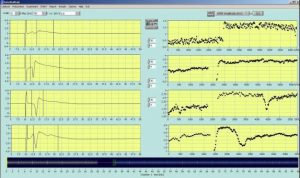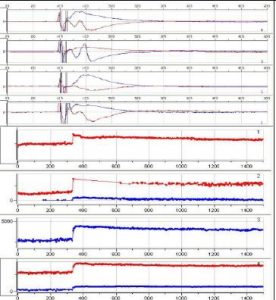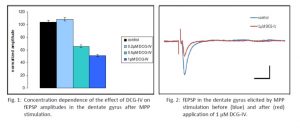Multiple slice Recording from brain slices
Long-term potentiation in the hippocampus
The hippocampus is a key structure in learning and memory. Memory formation is accompanied by long-term changes in synaptic transmission in hippocampal neurons. At the cellular level, long-term synaptic plasticity (long-term potentiation LTP, long-term depression LTD) can be observed as an increased efficacy in synaptic transmission leading to enhanced postsynaptic responses. Today it is accepted that pathophysiological changes in learning and memory as occuring with neurodegenerative deseases like Alzheimer are accompanied by changes in cellular LTP and LTD.
Metabotropic glutamate receptors
Metabotropic glutamate receptors (mGluRs) are expressed in many different structures of the mammalian CNS, they are involved in different functions, including motor control, spatial memory, olfactory priming, anxiety, and the perception of pain. A loss of mGluR expression can result in CNS malfunctions, like ataxia and learning deficits, and pathological activations of mGluRs have been reported to be linked to neurological disorders, like Chorea Huntington, Alzheimer’s disease, stroke, and epilepsy. Also, mGluRs may be involved in cognitive disorders and schizophrenia. Because they are becoming an increasingly interesting target for pharmacological compounds, reliable and easy-to-handle models for mGluR functions are needed. One model system to study mGluR function in vitro is the medial perforant path-dentate gyrus (MPP-DG) synapse in the hippocampus. In this system, application of the group-II mGluR agonist DCG-IV reduces postsynaptic responses in DG neurons to MPP stimulation.
Experimental models for epilepsy research
The development of antiepileptic drugs critically depends on experimental models that allow testing anticonvulsant effects. Epileptiform activity can be experimentally induced by a variety of methods both in vivo and in vitro, usually by either a reduction of postsynaptic inhibition or by a general increase of spontaneous activity. In vitro, the induction of epileptiform activity in hippocampal or neocortical brain slices can be achieved by an overactivation of postsynaptic NMDA receptors. Usually, NMDA receptors are blocked by Mg2+ ions and this Mg block is only released when postsynaptic neurons are activated through non-NMDA receptors. By reducing the concentration of extracellular Mg2+ ions, epileptiform activity can be easily and reproducibly evoked and antivonvulsant effects of bath-applied compounds can be recorded with minimum experimental effort. Because the hippocampal slice preparation is a well-defined experimental model and the application of Mg2+-free extracellular solutions is easy, this is perfectly suited for pharmacological studies of anticonvulsant compounds on a routinely basis.
References
- Nadasdi L, Nikolich K: Compounds for improving learning and memory, Amnestix, Inc. patents, PCT/US2009/043467, 2009
- Nikolich K, Nadasdi L: Compounds for rho kinase inhibition and for improving learning and memory, Amnestix, Inc. patents, USPTO Applicaton #20110294789, 2011
- Roux MS: Characterization of Panx1 in an experimental model of ischemia , Dissertation Univ. Bochum, Neuroanatomie und Molekulare Hirnforschung, 2012.
fEPSP and populations spikes in hippocampal slices under control conditions after paired pulse stimulation
fEPSP and populations spikes in hippocampal slices during superfusion with Mg 2+ free ACSF after paired pulse stimulation - Cao G, Harris KM: Developmental regulation of the late phase of long-term potentiation (L-LTP) and metaplasticity in hippocampal area CA1 of the rat. J. Neurophysiol. 107 (3), 902-912, 2012
- Novkovic T : Exploration of the molecular mechanisms underlying changes in hippocampal synaptic plasticity in health and disease. Dissertation Univ. Bochum, Dept. Neurophysiol., 2013.
- Kläschen J: The role of Arc/Arg3.1 in protein synthesis dependent and independent forms of synaptic plasticity Dissertation Univ. Hamburg, Institut für Molekulare und Zelluläre Kognition, 2013
- Cao G, Harris KM: Augmenting saturated LTP by broadly spaced episodes of theta-burst stimulation in hippocampal area CA1 of adult rats and mice. J. Neurophysiol. 112 (8), 1916-1924, 2014
- Novkovic T, Mittmann Th, Manahan-Vaughan D: BDNF Contributes to the Facilitation of Hippocampal Synaptic Plasticity and Learning Enabled by Environmental Enrichment Hippocampus 25: 1-15, 2015
- Dennissen FJA, Anglada-Huguet M, Sydow A, Mandelkow E, Mandelkow E-M: ,Adenosine A1 receptor antagonist rolofylline alleviates axonopathy caused by human Tau ΔK280, PNAS 113(41) 11597-11602, 2016
Contact Us
You need more information? Just send us an email – we will get in contact with you as soon as possible




